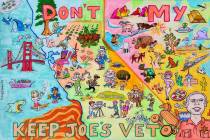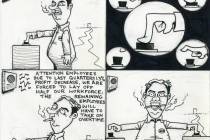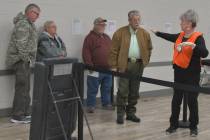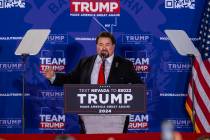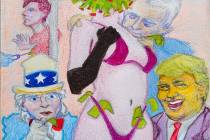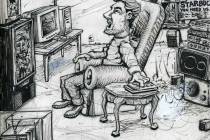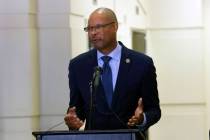Dennis Myers: How Nevada dealt with earlier Kaepernicks
On July 4, 1910, Jack Johnson fought Jim Jeffries in Reno in what was known as the Great White Hope Fight. Jeffries was the great white hope, Johnson an African-American champion. Johnson won, remaining the great black hope.
Muhammad Ali fought at least seven times in Las Vegas, at age 19 against Duke Sabedong in 1961, then against Floyd Patterson in 1965, Jerry Quarry in 1972, Joe Bugner in 1973, Ron Lyle in 1975, Leon Spinks in 1978, Larry Holmes in 1980. It was in Las Vegas early in his career that he met George Wagner, AKA wrestler Gorgeous George, who gave him some pointers on how to promote himself. Ali’s repeated Las Vegas bouts helped build the city’s image as a prizefight Mecca.
In 1968, Olympians John Carlos and Tommie Smith, among others, trained for the high altitude of the Mexico City Olympics at Echo Summit near Lake Tahoe. “This is where the love and bonding started amongst all of the individuals,” Carlos said on a 2014 return visit. “I hear many people talk about how great this team was. The greatness came from this location.”
When Jack Johnson was prosecuted under the misused Mann Act (designed to deal with white slavery, it was used in Johnson’s case against a consensual relationship), no Nevada leader spoke up for him, though he had helped put Reno on the map. During the Reno fight, a photograph was taken of all attending champions. Johnson was not included.
When Muhammad Ali was stripped of his title after he became a Muslim and made clear he wanted nothing to do with the U.S. government’s war against Vietnam, Nevada jumped on the bandwagon.
Nevada Gov. Paul Laxalt – who was not disturbed by the organized crime connections of some of his cronies – called the supposedly independent state athletic commission into “emergency” session and convinced them to cancel an Ali fight against Floyd Patterson, then counsel the governor of Pennsylvania to do the same.
Budd Shulberg wrote of Ali, “He thought he had it made in Las Vegas, but at the last minute the governor decided it would not be in the best interest of the great state of Nevada. The Mafia, yes; Ali, no.” Laxalt said he took the action in Patterson’s interests, which came as news to Patterson.
In 1968, no Nevada leader spoke up for Tommie Smith or John Carlos when they were expelled from the U.S. team for raising the clenched fist salute and bowing their heads during the “Star-Spangled Banner”.
We are now seeing another such cycle unfolding. Colin Kaepernick played for the University of Nevada, Reno, where he rolled up 10,000 passing yards and 4,000 rushing yards and was twice named Western Athletic Conference (WAC) Offensive Player of the Year.
When he began taking a stand by sitting or kneeling in protest against oppression of blacks and police violence, his former UNR athletic director, Chris Ault, stepped forward to undercut his former player: “I think there are better venues to express those interests and his ultimate message. You never lead by sitting down – during the national anthem or anywhere – so for me it’s not the message that’s troubling, it’s the platform and the way it was delivered.”
That puts the workers in the 1936-37 Flint, Michigan sit-in at General Motors and the civil rights activists in the 1960s sit-ins in their places. It’s-not-what-he-did-but-the-way-he-did-it is one of the oldest rationalizations in human history, and one with very little respectable heritage. It’s basically a way of objecting to a message or issue without seeming to do so.
“Howbeit he meaneth not so, neither doth his heart think so; but it is in his heart to destroy and cut off nations not a few,” Isaiah tells us. There’s an episode of MASH in which “B.J. Hunnicutt” is siding with “Hawkeye” until he said, “What I didn’t like was the WAY she did it.”
We don’t get to pick and choose our spots that easily. We either support Kaepernick’s protest or not. The issue is important, not how it is expressed. Baltimore Ravens team owner Steve Bisciotti is so fastidious that he distinguishes among Kaepernick’s two forms of protest: “Non-violent protesting is something that we have all embraced. I don’t like the way he did it. Personally, I kind of liked it a lot when he went from sitting to kneeling. I don’t know, I’m Catholic – we spend a lot of time kneeling.”
So police violence is OK when it’s protested by sitting but not when it is protested by kneeling? Now, THAT’S finicky. Or is what bothers Bisciotti that Kaepernick is Protestant? (The Ravens’ Terrell Suggs joined Kaepernick in kneeling after Donald Trump called for owners to fire protesting players.
Jack Johnson, John Carlos and Tommie Smith, and Muhammad Ali are now all honored and respected. There are statues of all of them in the United States and those who attacked them now look foolish if not malicious. Colin Kaepernick’s critics are choosing every day how they want to be remembered in this dispute.
Dennis Myers is an award-winning journalist who has reported on Nevada’s capital, government and politics for several decades. He has also served as Nevada’s chief deputy secretary of state.







